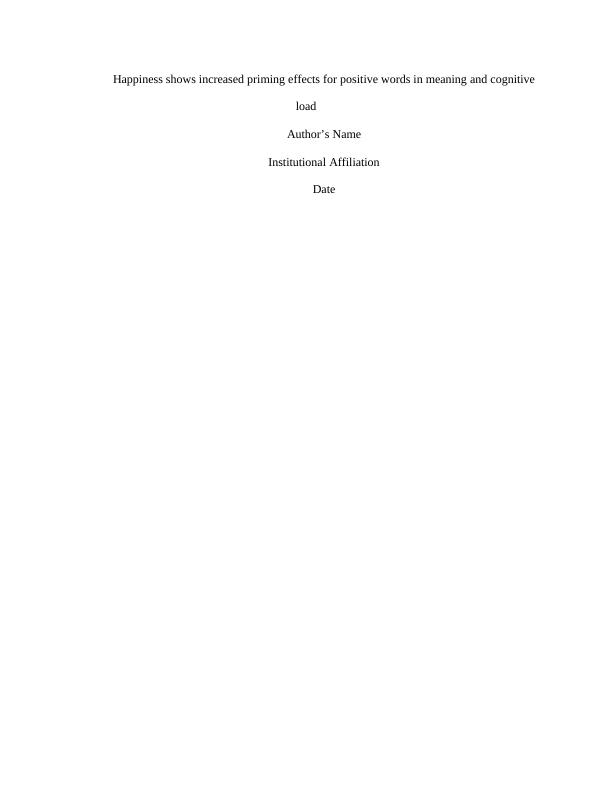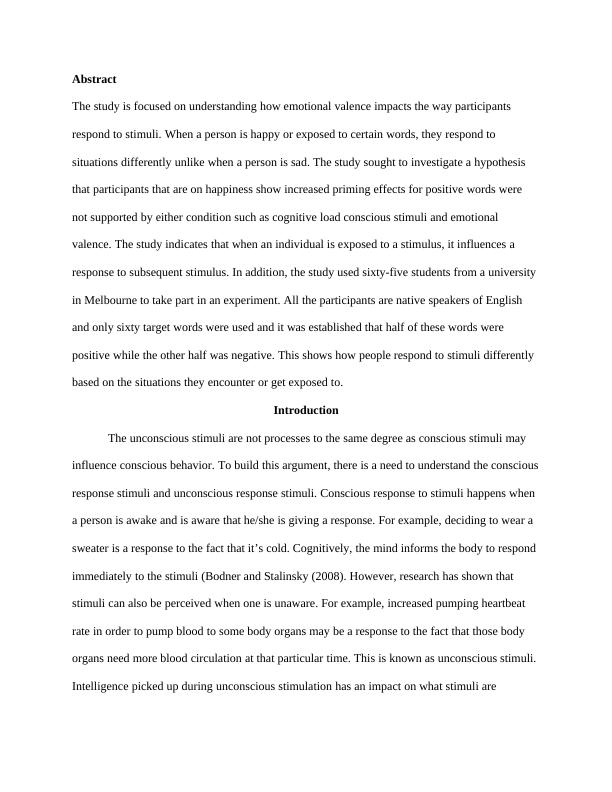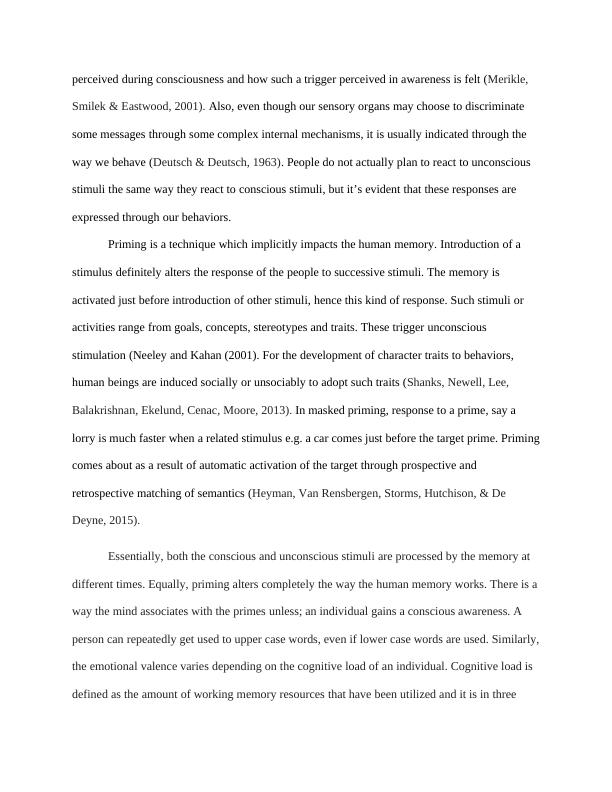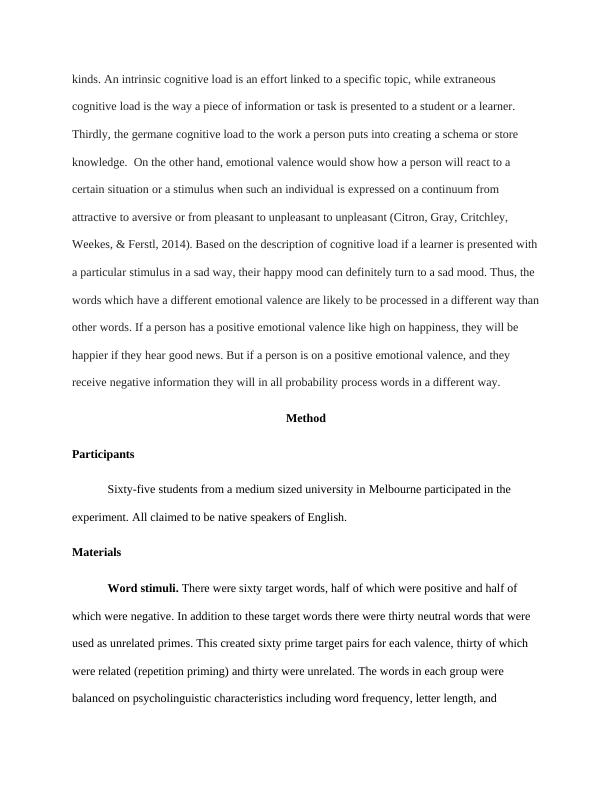Happiness and Priming Effects for Positive Words
Added on 2023-01-17
15 Pages3855 Words22 Views
Happiness shows increased priming effects for positive words in meaning and cognitive
load
Author’s Name
Institutional Affiliation
Date
load
Author’s Name
Institutional Affiliation
Date

Abstract
The study is focused on understanding how emotional valence impacts the way participants
respond to stimuli. When a person is happy or exposed to certain words, they respond to
situations differently unlike when a person is sad. The study sought to investigate a hypothesis
that participants that are on happiness show increased priming effects for positive words were
not supported by either condition such as cognitive load conscious stimuli and emotional
valence. The study indicates that when an individual is exposed to a stimulus, it influences a
response to subsequent stimulus. In addition, the study used sixty-five students from a university
in Melbourne to take part in an experiment. All the participants are native speakers of English
and only sixty target words were used and it was established that half of these words were
positive while the other half was negative. This shows how people respond to stimuli differently
based on the situations they encounter or get exposed to.
Introduction
The unconscious stimuli are not processes to the same degree as conscious stimuli may
influence conscious behavior. To build this argument, there is a need to understand the conscious
response stimuli and unconscious response stimuli. Conscious response to stimuli happens when
a person is awake and is aware that he/she is giving a response. For example, deciding to wear a
sweater is a response to the fact that it’s cold. Cognitively, the mind informs the body to respond
immediately to the stimuli (Bodner and Stalinsky (2008). However, research has shown that
stimuli can also be perceived when one is unaware. For example, increased pumping heartbeat
rate in order to pump blood to some body organs may be a response to the fact that those body
organs need more blood circulation at that particular time. This is known as unconscious stimuli.
Intelligence picked up during unconscious stimulation has an impact on what stimuli are
The study is focused on understanding how emotional valence impacts the way participants
respond to stimuli. When a person is happy or exposed to certain words, they respond to
situations differently unlike when a person is sad. The study sought to investigate a hypothesis
that participants that are on happiness show increased priming effects for positive words were
not supported by either condition such as cognitive load conscious stimuli and emotional
valence. The study indicates that when an individual is exposed to a stimulus, it influences a
response to subsequent stimulus. In addition, the study used sixty-five students from a university
in Melbourne to take part in an experiment. All the participants are native speakers of English
and only sixty target words were used and it was established that half of these words were
positive while the other half was negative. This shows how people respond to stimuli differently
based on the situations they encounter or get exposed to.
Introduction
The unconscious stimuli are not processes to the same degree as conscious stimuli may
influence conscious behavior. To build this argument, there is a need to understand the conscious
response stimuli and unconscious response stimuli. Conscious response to stimuli happens when
a person is awake and is aware that he/she is giving a response. For example, deciding to wear a
sweater is a response to the fact that it’s cold. Cognitively, the mind informs the body to respond
immediately to the stimuli (Bodner and Stalinsky (2008). However, research has shown that
stimuli can also be perceived when one is unaware. For example, increased pumping heartbeat
rate in order to pump blood to some body organs may be a response to the fact that those body
organs need more blood circulation at that particular time. This is known as unconscious stimuli.
Intelligence picked up during unconscious stimulation has an impact on what stimuli are

perceived during consciousness and how such a trigger perceived in awareness is felt (Merikle,
Smilek & Eastwood, 2001). Also, even though our sensory organs may choose to discriminate
some messages through some complex internal mechanisms, it is usually indicated through the
way we behave (Deutsch & Deutsch, 1963). People do not actually plan to react to unconscious
stimuli the same way they react to conscious stimuli, but it’s evident that these responses are
expressed through our behaviors.
Priming is a technique which implicitly impacts the human memory. Introduction of a
stimulus definitely alters the response of the people to successive stimuli. The memory is
activated just before introduction of other stimuli, hence this kind of response. Such stimuli or
activities range from goals, concepts, stereotypes and traits. These trigger unconscious
stimulation (Neeley and Kahan (2001). For the development of character traits to behaviors,
human beings are induced socially or unsociably to adopt such traits (Shanks, Newell, Lee,
Balakrishnan, Ekelund, Cenac, Moore, 2013). In masked priming, response to a prime, say a
lorry is much faster when a related stimulus e.g. a car comes just before the target prime. Priming
comes about as a result of automatic activation of the target through prospective and
retrospective matching of semantics (Heyman, Van Rensbergen, Storms, Hutchison, & De
Deyne, 2015).
Essentially, both the conscious and unconscious stimuli are processed by the memory at
different times. Equally, priming alters completely the way the human memory works. There is a
way the mind associates with the primes unless; an individual gains a conscious awareness. A
person can repeatedly get used to upper case words, even if lower case words are used. Similarly,
the emotional valence varies depending on the cognitive load of an individual. Cognitive load is
defined as the amount of working memory resources that have been utilized and it is in three
Smilek & Eastwood, 2001). Also, even though our sensory organs may choose to discriminate
some messages through some complex internal mechanisms, it is usually indicated through the
way we behave (Deutsch & Deutsch, 1963). People do not actually plan to react to unconscious
stimuli the same way they react to conscious stimuli, but it’s evident that these responses are
expressed through our behaviors.
Priming is a technique which implicitly impacts the human memory. Introduction of a
stimulus definitely alters the response of the people to successive stimuli. The memory is
activated just before introduction of other stimuli, hence this kind of response. Such stimuli or
activities range from goals, concepts, stereotypes and traits. These trigger unconscious
stimulation (Neeley and Kahan (2001). For the development of character traits to behaviors,
human beings are induced socially or unsociably to adopt such traits (Shanks, Newell, Lee,
Balakrishnan, Ekelund, Cenac, Moore, 2013). In masked priming, response to a prime, say a
lorry is much faster when a related stimulus e.g. a car comes just before the target prime. Priming
comes about as a result of automatic activation of the target through prospective and
retrospective matching of semantics (Heyman, Van Rensbergen, Storms, Hutchison, & De
Deyne, 2015).
Essentially, both the conscious and unconscious stimuli are processed by the memory at
different times. Equally, priming alters completely the way the human memory works. There is a
way the mind associates with the primes unless; an individual gains a conscious awareness. A
person can repeatedly get used to upper case words, even if lower case words are used. Similarly,
the emotional valence varies depending on the cognitive load of an individual. Cognitive load is
defined as the amount of working memory resources that have been utilized and it is in three

kinds. An intrinsic cognitive load is an effort linked to a specific topic, while extraneous
cognitive load is the way a piece of information or task is presented to a student or a learner.
Thirdly, the germane cognitive load to the work a person puts into creating a schema or store
knowledge. On the other hand, emotional valence would show how a person will react to a
certain situation or a stimulus when such an individual is expressed on a continuum from
attractive to aversive or from pleasant to unpleasant to unpleasant (Citron, Gray, Critchley,
Weekes, & Ferstl, 2014). Based on the description of cognitive load if a learner is presented with
a particular stimulus in a sad way, their happy mood can definitely turn to a sad mood. Thus, the
words which have a different emotional valence are likely to be processed in a different way than
other words. If a person has a positive emotional valence like high on happiness, they will be
happier if they hear good news. But if a person is on a positive emotional valence, and they
receive negative information they will in all probability process words in a different way.
Method
Participants
Sixty-five students from a medium sized university in Melbourne participated in the
experiment. All claimed to be native speakers of English.
Materials
Word stimuli. There were sixty target words, half of which were positive and half of
which were negative. In addition to these target words there were thirty neutral words that were
used as unrelated primes. This created sixty prime target pairs for each valence, thirty of which
were related (repetition priming) and thirty were unrelated. The words in each group were
balanced on psycholinguistic characteristics including word frequency, letter length, and
cognitive load is the way a piece of information or task is presented to a student or a learner.
Thirdly, the germane cognitive load to the work a person puts into creating a schema or store
knowledge. On the other hand, emotional valence would show how a person will react to a
certain situation or a stimulus when such an individual is expressed on a continuum from
attractive to aversive or from pleasant to unpleasant to unpleasant (Citron, Gray, Critchley,
Weekes, & Ferstl, 2014). Based on the description of cognitive load if a learner is presented with
a particular stimulus in a sad way, their happy mood can definitely turn to a sad mood. Thus, the
words which have a different emotional valence are likely to be processed in a different way than
other words. If a person has a positive emotional valence like high on happiness, they will be
happier if they hear good news. But if a person is on a positive emotional valence, and they
receive negative information they will in all probability process words in a different way.
Method
Participants
Sixty-five students from a medium sized university in Melbourne participated in the
experiment. All claimed to be native speakers of English.
Materials
Word stimuli. There were sixty target words, half of which were positive and half of
which were negative. In addition to these target words there were thirty neutral words that were
used as unrelated primes. This created sixty prime target pairs for each valence, thirty of which
were related (repetition priming) and thirty were unrelated. The words in each group were
balanced on psycholinguistic characteristics including word frequency, letter length, and

End of preview
Want to access all the pages? Upload your documents or become a member.
Related Documents
Analysis of the response rate to cognitive loadlg...
|10
|2254
|22
Semantic Priming: Influence of Emotional Valence Words on Cognitive Processinglg...
|13
|3666
|27
Emotional Valence Words on a Level of Masked Repetitive Priming and its Effectlg...
|15
|4023
|18
Cognitive Psychology: Understanding Mental Processes and Stimulilg...
|8
|1823
|26
Various Cognitive Development Assignmentlg...
|14
|3710
|15
Self-Esteem and Measuring Scalelg...
|7
|1046
|220
